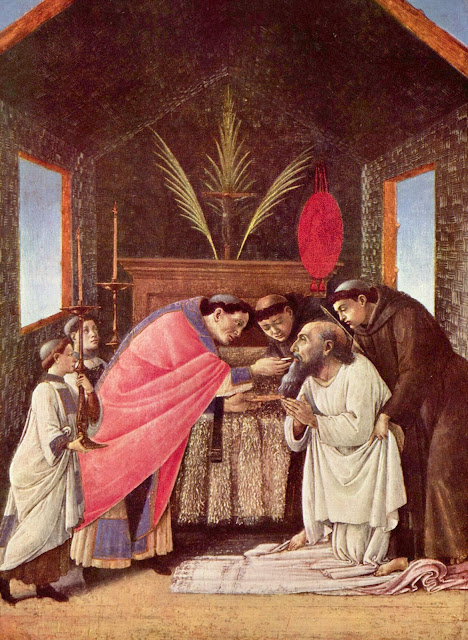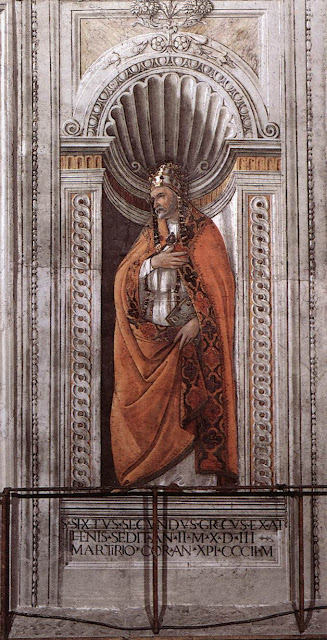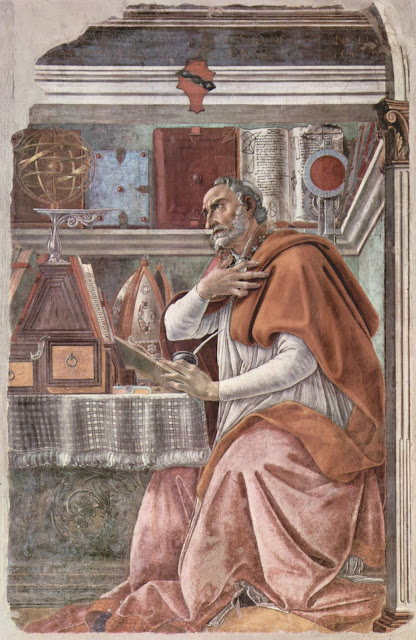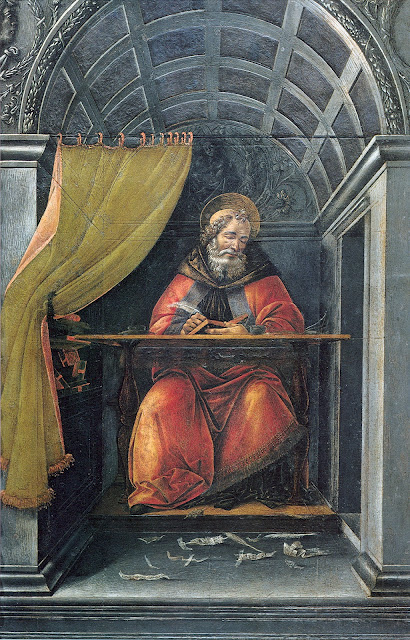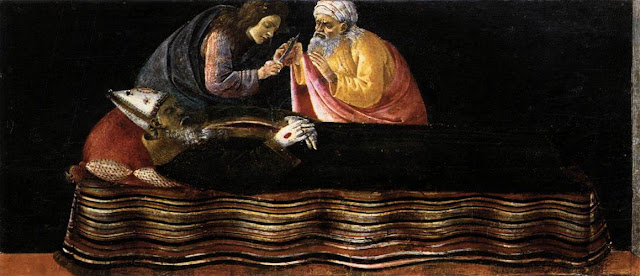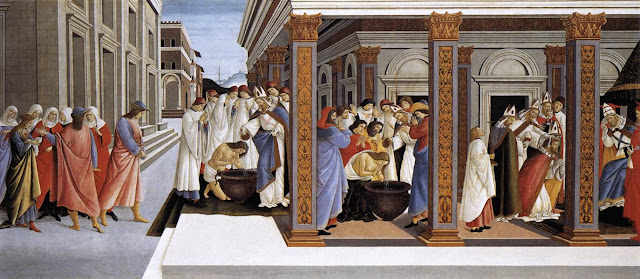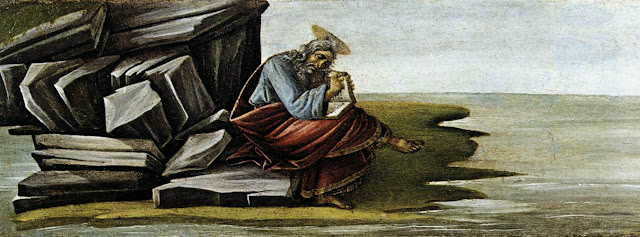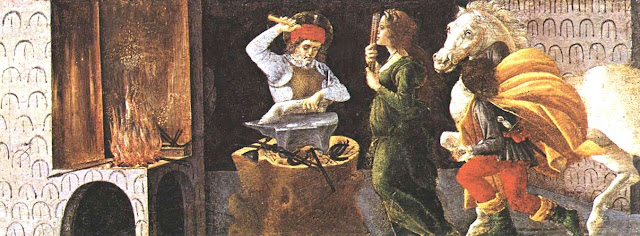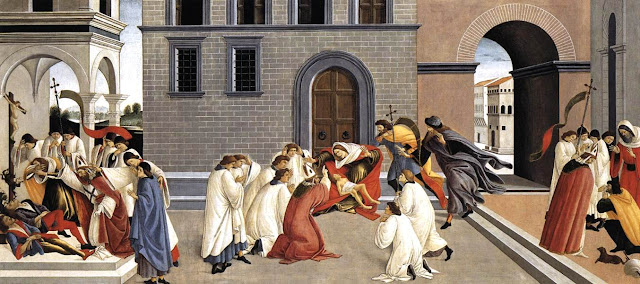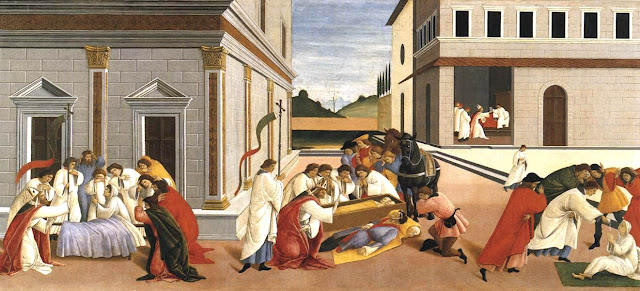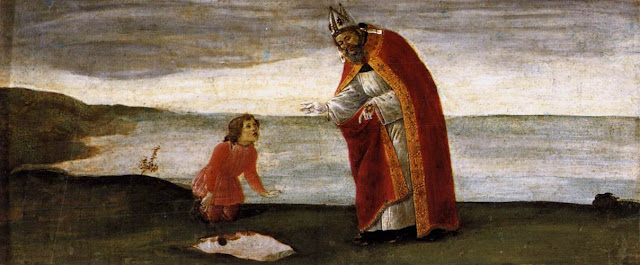The Saints Paintings of Botticelli
https://phistars.blogspot.com/2012/07/saints-paintings-of-botticelli.html
The Saints Paintings of Botticelli
The first saint painting features Saint Francis of Assisi. He is a very important Catholic Saint. He traveled as far as the middle east to convert the "infidels". I think I mentioned this saint before. I hate repeating myself. Lets just continue. Here the saint is surrounded by angels. This arrangement is very similar to Gothic frescoes. They always had a lot of golden decorations. In any case, this Botticelli painting deserves 5 star rating.
The next painting is called "The Last Communion of St.Jerome". When a Saint, the Pope or a lay follower is near death, he usually receives his last communion. This communion is different from all the others. Its also part of the seven rites of the Catholic church. It supposed to get your soul nice and clean, ready to enter paradise.
This Saint translated and commented on the Hebrew Bible. He also defended the theory of the perpetual virginity of the Virgin. He also wrote lots of other theological writings. In this painting, we see several ranking officers of the church. Those supporting St. Jerome are monks. The man in red is a Bishop. The two children behind him are Deacons. The scenery itself is a lil hut. The saint is kneeling on a humble mat. On the fireplace, there are three sacred palms and a cross. Its a simple, recognizable scenery, if you are an Italian Renaissance man. I think that is all worth mentioning. Botticelli's St.Jerome painting deserves 5 star rating.
The next painting shows St. Sebastian impaled by arrows. His body is in a classical Greek contraposto. His expression is restrained. He still is a bit bloody. In the background, there is a Medieval port town. There are also some other Italian guys walking about the road. Its a juxtaposition of a religious figure and the real world of Botticelli's contemporaries. This painting deserves 5 star deserves 5 star rating.
This painting is shows Pope Sixtus II (1481) in a Bishop attire. This Pope died martyr under the reign of Emperor Valerian. He is credited for restoring the shaky relationships with the Eastern Orthodox churches. This fresco is illusionist. It gives the impression that the saint's statue has come to life. Its place in a painted niche like regular sculptures. Bellow him, we see his full name and those who commissioned this painting. Anyhow, the dead painter Botticelli deserves 5 star rating.
The next painting shows St. Augustine. He was from North Africa, born in 354 AC. He was a Greek that converted to Christianity. He brought many of the Platonic concepts into Catholicism. He created the concept of the Original Sin and Just Wars (the Catholic equivalent of a Muslim Jihad). Thanks to him we had the crusades and the Dark Ages. Hehehehehe! Botticelli painted this saint inside his study. He has his hand in his heart while he prepares to write. Before him, there is an open bible. He is dressed like a Bishop, and the Bishop hat is nearby. Around the top there are some books. The one that's open to our viewing is a Trigonometry book. On the far left, there is the Ptolemaic model of the universe. This model has the Earth at the center of the universe. Its funny, Galileo proved that the earth revolved around the sun. Then, comes Einstein and says that it depends. Anyhow, this fresco of Botticelli deserves 5 star rating.
The next painting shows St. Augustine in his Cell (1490-1494). Here the Saint is translating the Bible. On the floor, we see the discarded translations. His face really does look serene. He truly is enjoying his work. The curtain parted gives an air of intimacy to this painting. We have just intruded on this man private work. The roof of his cells looks a lot like the roofing of the Colosseum. The entire scenery is just like a Greek temple. The details on his beard are amassing. That Botticelli spent a lot of time painting each individual string. Well, you got to try some cool realism effects to impress those rich Medici church patrons. In any case, Botticelli gets another 5 stars.
The next painting is called "Extraction of St. Ignatius Heart". This saint was the founder of the Jesuits. His spiritual exercises were key in the Counter Reformation. When he died the church Fathers took out his heart and made it into a relic. Another proof that he was a saint was the Stigmata on his dead body. Pretty neat. In any case, this lovely painting deserves 5 star rating.
The next painting is called "Baptism of St. Zenobius and his Appointment as Bishop" (1505). This man was the first Bishop of Florence. The Baptism image repeats itself both inside and outside the house. Toward the far right, the man in red, St. Zenobius, is being made a Bishop. They are about to put on him his little hat. The scenery looks Romanesque. The placement of the figures is similar to relief sculptures. There are no humans in the background. Most figures are dressed like Italian Renaissance men. I think that's all worth mentioning. 5 stars for Botticelli.
Here we see St. Jerome in solitude. Those Saints do love the life of a Hermit. His clothing is very similar to those worn by Greek Philosophers. Around him there are some books, a cross and skull. The skull is to meditate on mortality and the death of Christ. The scenery itself is a bit simplified. Its just a forest. Anyhow, more 5 stars for Botticelli.
This time St. Jerome is just sitting down composing by the ocean. Nature does inspire certain people. The background is really simplified. Then again, Botticelli was a people person. If you get my joke. 5 stars.
The next painting is called "The Miracle of St. Eligius" . Its the predella panel from the altarpiece of St. Mark (1492). This man is the patron saint of blacksmiths and horses. Here this saint is working at his forge. The legend goes that using his miraculous forge, he took the leg off a horse. The horse was being evil and it did not feel like working. The Saint took his leg off and put it back on again. In this painting, the Saint is working his forge. A maiden is watching in awe. Meanwhile, an assistant is holding up whats left of the horse's severed leg. The horse looks realistic. The people again are in a relief like arrangement. As for the fire, its plain cheap. Anyhow, Botticelli deserves 5 star rating.
The next painting is called "Three miracles of St Zenobius" (1505). In the first one, he is healing two sick men. In the center one, he is reviving a dead child. His mother is watching in awe. The last one he is curing the sores of a leaper. 5 stars.
Here are three other miracles by the same saint. From the left to right, first he is healing the sick. Next he brought back the dead. Lastly, he was in another house. You can see him, inside the open house in the background. Then, one of his followers produced water out of thin air. He did this by invoking the Saint's name. 5 stars for Botticelli. 5 stars.
The next painting shows the Transfiguration St. Jerome and St. Augustine (1500). Both Saints are in the corner of the painting. On the center panel, there are some cowering apostles. In the center, there is the Resurrected Christ. On the right hand of Christ, there is St. Peter. On his left, is John the Baptist. John the Baptist is always portrayed in furs. The highest details are on Christ. The glowing was painted with real gold. His dress looks extremely delicate. His... round belly shows that Christ is fertile. Full of Grace if you would. Weird! In any case, this painting deserves 5 star rating.
The last painting is "The Vision of St. Augustine from the altarpiece of St. Barnabas". Here a boy has just seen St. Agustine. He is kneeling down in front of the Saint. The background is a bit half backed. Then again, it has been like 1500 years since a European had painted a background. I think those are all the Saint paintings.I hope that this has humored you even a little bit. 5 stars for Botticelli. Tata and goodnight.

